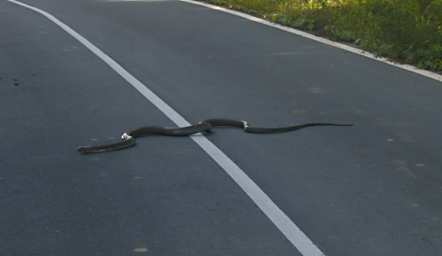
C.K. dropped us off at the office for the Danum Valley Field Center. We had instructions to be there by 3:00 p.m.; that's when the only transportation to the Field Center left. The Danum Valley Conservation Area is one of the largest relatively undisturbed lowland rainforests left in Southeast Asia. The Borneo Rainforest Lodge is an upscale tourist accomodation located in the conservation area, but it's out of our price range. We were staying at the Danum Valley Field Center, and even it was a bit pricey for non-research visitors like us. In fact, I didn't have enough Indonesian cash with me to cover it. Ram and Dawn were sharing a room; I was alone and the price for a room was the same; I had erroneously assumed it would be about half that. I asked if something else was available, and the woman behind the counter informed me I could stay in the hostel. I was fine with that. C.K. told me I really didn't want to do that, as the hostel is "a long ways and up a hill" from the dining hall, but I figured the walk would be good for me.
There were a number of other adventurous souls waiting for the van to take us to Danum. Eventually the van arrived, preceeded by a pickup. We piled our packs into the back of the truck, then squeezed into the van and we were off. Within three miles we got a real treat -- ahead of us on the road was a big snake. Also ahead of us on the road was a small car, a sort of Ford Fiesta kind of car. The car, traveling at slow speed, swerved to avoid the snake; the snake, apparently pissed off, rose up and looked into the back window of the car, at which point we could see it was a cobra. Whoa! Cool! It was a good sized snake, roughly three meters long; I guess that's probably average for a cobra.
 |
| Cobra |
At the dining hall we ran into a bunch of the research crew for Tom Martin whom we had just seen a week before up at Mt. Kinabalu. They were on a four day break, so what did they do? They headed down to Danum Valley to look at more birds! Different birds from the ones they were studying up on the mountain.
The hostel dorms were pretty warm, but there were overhead fans and windows with cross ventilation. The showers worked, and as a practical matter, we didn't spend a lot of time in the hostel. Instead, people congregated on the "porch" where there were tables and places to cook. It was a great opportunity to talk with people doing research and trade information of what people had seen and when and where they had seen it. I got some valuable information about places to look for birds and a little more about the layout of the area as a whole
We spent the next morning high up in one of the huge old Tualong trees, also known as "Mengaris", on an aging platform reached by a rickety home-grown ladder. Made from cheap aluminum extension ladder segments lag bolted to the tree trunk, with a safety cage made of re-bar, it was a bit awkward to ascend with a backpack on. But it got us up, and up was a good place to be!
Tualong trees have huge buttresses to help support them, their roots spreading out widely. Because rainforest soil is neither deep nor particularly fertile, spreading roots over the upper soil instead of sending them down deep is a way to maximize nutrient gathering; but to stay upright, they need those big buttresses
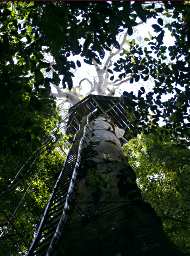 |
 |
 |
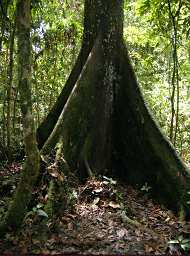 |
| Platform in Tualong Tree | Ram Climbing Up to the Platform | Dawn Climbing Up to the Platform | Tree Buttresses |
Our platform tree was a nice big one; big enough to have not one, but two platforms. The first was some 30m or so off the ground (my wild guess at height), and the second was another 10m higher up.
 |
| Rainforest Panorama from the Tree Platform |
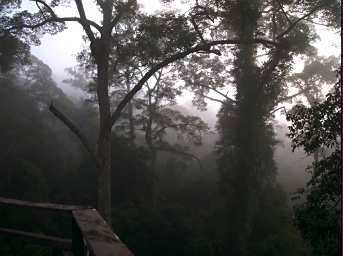 |
 |
| Rainforest | Spider Web |
One of Tom Martin's researchers, Connor, shared the platform with us for a while. He was hoping to see the Bornean Bristlehead, a bird we were anxious to see also. There weren't any around, but in the meantime it was great to have extra eyes to help spot and identify other birds.
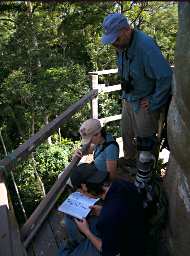 |
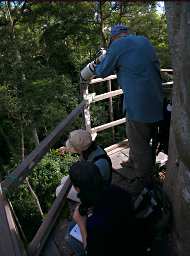 |
 |
| Connor, Dawn, and Ram
Working to Identify a Bird |
Connor, Dawn, and Ram
Making sure Everyone Sees the Bird |
Connor, Dawn, and Ram;
Checking the Bird Out |
That evening Connor and Jordan joined us on the platform again, but again we came up short on the Bristleheads. But we did have other birds to keep us on our feet.
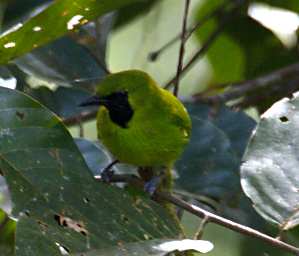 |
 |
| Greater Green Leafbird | Black Winged Flycatcher Shrike |
The Danum Valley Field Center is located along the Sagama River, and most of the trails are on the other side of the river from the lodging, dining, and other facilities. To get across the river, there are a couple of pedestrian suspension bridges. They are a great way to get across the river.
 |
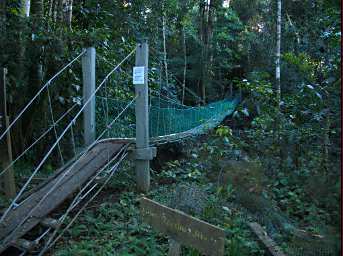 |
| Dawn Crossing the "Main" Suspension Bridge
Over the Sagama River |
Dawn Crossing another
Suspension Bridge |
At dinner one evening I had a conversation with a woman and her assistant who were here researching Trap-Jaw Ants, sometimes referred to as Snap-Jaw Ants. Apparently they have the fastest jaws around, clocked at something like 90 mph. In addition, the ants use their snapping jaws to jump into the air, possibly to get a quick start to escape enemies. She said if you get close to a nest you can hear them snapping their jaws as a kind of defensive warning mechanism.
We saw a variety of wildlife at Danum, and it was great knowing this was pretty much their natural environment.
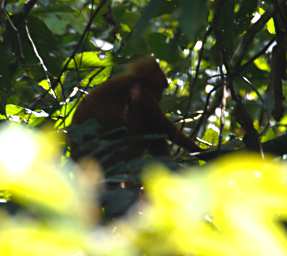 |
 |
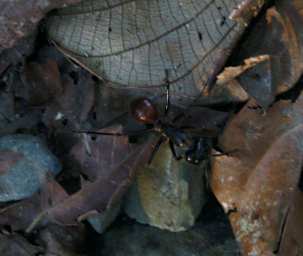 |
| Orangutan | Tualang Tree | Giant Ant |
Back at the hostel in the evening, I had a great conversation with Adam Mitchell and some of his other Compatriots from Tom Martin's crew. Connor showed up, a big satisfied grin on his face; he had had a great view of Bristleheads at a different platform, and that's where the others had seen them as well.
Ram and I went for a night drive with a number of Tom's folks, and it was a big success. We saw some Crested Fireback Pheasants, a giant squirrel, and a flying squirrel that did an amazing, slow glide from high in one tree across our road to another tree on the other side. Our spotter was able to keep his light on the squirrel the whole way, and I wish I had been able to get a picture of it. It was truly amazing.
We spent the next morning at the "other" tower, and saw Bornean Bristleheads almost as soon as we got up there. The morning was still early, and there was still that early morning fog hanging around, so we didn't get a great view of them, and after a while they disappeared. A bit later they came back and we had some great views of them, along with some others
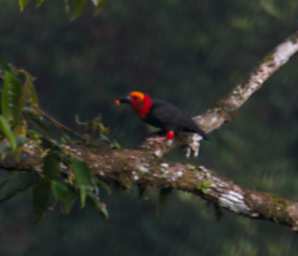 |
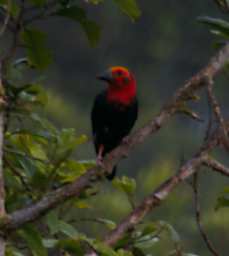 |
| Bornean Bristlehead | Bornean Bristlehead |
 |
 |
| Black And Yellow Broadbill | Xxx Yellow Bellied Prinia |
 |
 |
| Scarlet Rumped Trogon | Scarlet Rumped Trogon |
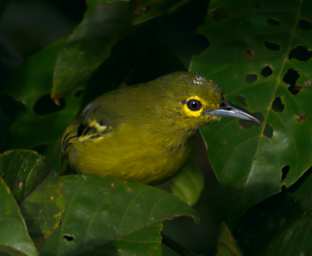 |
 |
| Xxx | Black Bellied Malkoha |
Ram and I were still up in the tower and about to come down when we noticed some movement in a tree some distance away. It turned out to be a mother Gibbon and child, and they slowly moved towards us until they were just below us. While that was going on some high school age kids were coming up the trail to the tree, totally unaware of what was going on barely above their heads.
 |
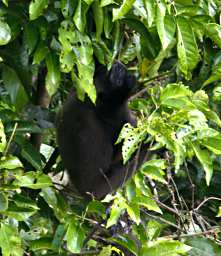 |
 |
| Gibbons | Gibbon Kid | Gibbon Kid |
It was a hot day, and Ram headed back to cool off. I took a walk by myself and ended up down by the river. Hot and in need of cooling off, I went for a much-appreciated swim in a great swimming hole.
 |
| Swimming Hole |
On my way back from the swimming hole I came across a tree with some bright red fruit or seed pods of some sort growing directly off its trunk. I don't know what it was, but it was sure colorful, and if it was edible, it must either be pretty abundant, hadn't been there very long, or whatever ate it was color-blind.
 |
 |
 |
| Tree Fruit | Segama R | Segama R |
Ram and Dawn and I were still chasing Pittas, and Andy and a couple of his co-researchers had seen them more than once. They told us a couple of places where they had seen them regularly, and so we headed that direction. We took our time, and after a number of attempts and lots of time, we saw something, but not well enough or for long enough to get any definitive identification. It was frustrating, but that's life in the woods.
While that was going on, though, we also had a wonderful display by a couple of butterflies, the Common Tree Nymph.
 |
 |
| Common Tree Nymph | Common Tree Nymph |
 |
| Common Tree Nymph |
Walking back to the hostel in the evening, I stopped to look in the interpretive center display they have. There was a butterfly / moth / beetle display case, and it had a really cool, huge 3-horned beetle -- two upper horns curved down and one lower horn curved up. A model tractor grapple, courtesy of Mother Nature, thousands of years before mankind ever thought of the idea. I think it was a Chalcosoma Atlas but I didn't write it down...
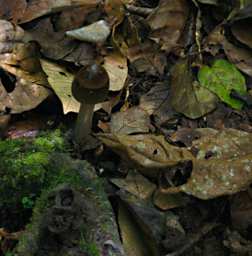 |
| Mushroom |
 |
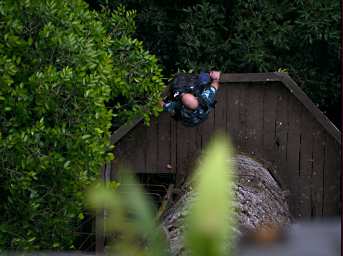 |
| Ram Climbing up to a Canopy Tower | Ram on a Canopy Tower |
After three days our time was up, and we returned to Lahad Datu. Lahad Datu is pretty close to Semporna, which is the jumping off place for diving at Sipidan Island, and I was kicking myself a bit for not having thought ahead and allowed a few extra days to go diving out there. If I live long enough, maybe I'll get a chance to come back and do that. Meanwhile, we boarded a plane back to Kota Kinabalu. I wished the weather had been better, for we could have had a great view of the island of Borneo and the seas around it. What we did get a view of, was the depressing extent of deforestation and oil-palm plantations displacing tropical jungle.
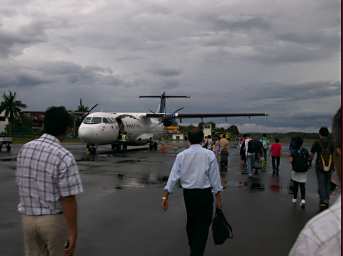 |
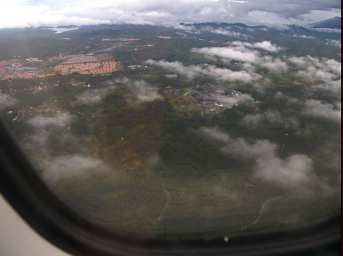 |
| Lahad Datu Airplane | Oil Palms |
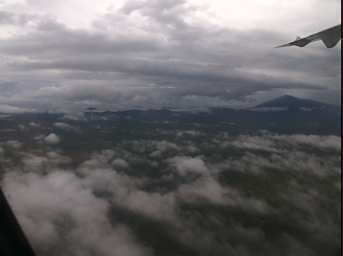 |
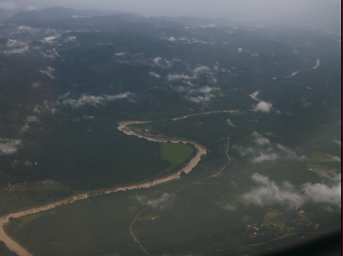 |
| Borneo from the Air | River and Oil Palms from the Air |